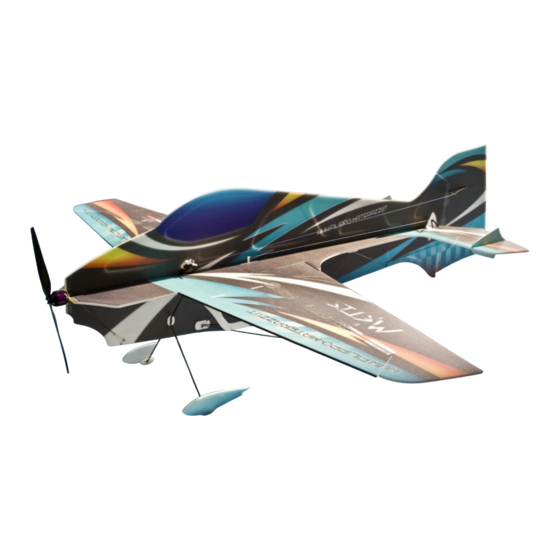
Advertisement
Quick Links
METIS INSTRUCTIONS
The Metis was designed by Filippo Materazzi, F3P, Aeromusical and
F6A Italian Champion. It is the last version of his famous indoor
freestyle airplane which he flew in World Air Games 2009. It has
been totally updated but maintaining its particular style. Now it has
bigger mobile surfaces, a higher top and bottom fuselage and a
completely new milling, paying attention to maintain the strength of
the airframe. Thanks to all these tricks it flies slowly and smoothly
but it can become very agile, reactive and fast if you need it. This
characteristic is fundamental for an aeromusical flight where you
need to change the flight style according to the music, but also in a
good freestyle, to differentiate the maneuvers and employ the own
imagination. In addition, a beginner can improve his skills gradually,
increasing step by step the movement of mobile surfaces.
The kit is composed by 3 mm and 2 mm depron, carbon rods (precutted!),
super lightweight carbon control horns and all the
necessary to complete the plane.
Before operating this unit, please read these instructions
completely.
Before assembly, please spend some time to read our instructions.
Along the way you'll learn how to properly assemble your new
airplane in the least amount of time possible. Below are some tips
that will help you in the assembly.
1
Advertisement

Summary of Contents for Tech One 02A-703 Metis
- Page 1 METIS INSTRUCTIONS The Metis was designed by Filippo Materazzi, F3P, Aeromusical and F6A Italian Champion. It is the last version of his famous indoor freestyle airplane which he flew in World Air Games 2009. It has been totally updated but maintaining its particular style. Now it has bigger mobile surfaces, a higher top and bottom fuselage and a completely new milling, paying attention to maintain the strength of the airframe.
- Page 2 1. You need to consider the reserved servo position when installing the elevator and rudder. Also make sure that moving control surfaces do not interfere with reinforcement parts such as strings and linkage poles. 2. Before fixing carbon with C/A, paper the part that is going to be inserted and fixed in the depron.
- Page 3 Do not fly under the conditions below Windy conditions A street with many trees or street lamps Close to high voltage electrical wires High Population density areas Cautions for flying Metis is made for indoor flight. Of course it is able to fly outdoor in not much windy condition.
- Page 4 Cut a 55º bevel on ailerons. On elevator and rudder cut a 40° bevel on mobile and fixed surface. Fix the elevator with 3M tape.Do the same with ailerons. Fix the horizontal fuselages to the wing with C/A. Use some C/A to glue the two carbon strip (73 and 79.2 cm long) on both sides of the wi n g a s sh own i n th e p i cture.
- Page 5 Inser t the downside vertical winglets Fix with C/A the two 2 mm depron rei- into the pre-reser ved slots on the do- nforcement parts on both sides of lower w n s i d e o f t h e w i n g a n d a p p l y some vertical fuselage.
- Page 6 Install all the carbon rods as shown in Fix with C/A the four 2 mm depron rei- the pictures. Fir st of all fix wi th C/A nforcement half-moons on the bottom the four 1.5 mm ( 2 9 . 3 c m l o n g ) wi n g of horizontal fuselage as shown in the carbon rods.
- Page 7 Fix with C/A the two 3 mm round depron reinforcements on the bottom of hori- zontal fuselage as shown in the picture. The micro holes indicate the position. T he y are necessar y to reinfor ce the joint of the landing gear legs. Fix with C/A the three 1 mm carbon rods as shown in the pictures.
- Page 8 Install the 1 mm x 16 cm carbon r od Use some C/A to fix the elevator ser vo paying attention to the elevator def- in the pre-reser ve d sl o t o n th e l owe r lection.
- Page 9 Use C/A to fix the upper vertical fuse- lage into the horizontal fuselage. Be Insert the 0.5 mm x 32.5 cm carbon strip ver tical, no distor tion. in the elevator control horn. Then glue them together in the pre-reser ved slot. ATTENTION: elevator and rudder control horns are asymmetric.
- Page 10 Use receiver to trim the ser vo arms in Connect the elevator and rudder servos neutral, then fix the servo arms. Install and co n tr o l h o r n s wi th thread. Make ailerons linkages using the four clips su r e th e th r e a d i s ta u t a n d have the and the two 1.3 mm x 5 cm carbon rods control surfaces in a horizontal position.
- Page 11 Do the same on “tail landing gear” as shown in the picture. A perfect Metis is done after your car- eful assembly. While assembly, the fl- ying weight is really critical to the fli- ght perfor mance and will be affected by adding weight, so you should reduce any unnecessary weight while assembly.
- Page 12 www.fmdplanes.com www.filippo-materazzi.it For technical informations about planes, www.techonehobby.com pls contact with: filippo.materazzi@gmail.com Email:techonesales4@gmail.com...

Need help?
Do you have a question about the 02A-703 Metis and is the answer not in the manual?
Questions and answers